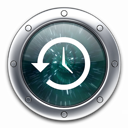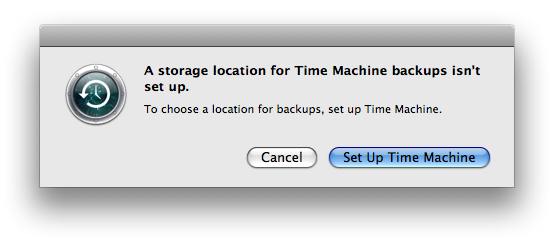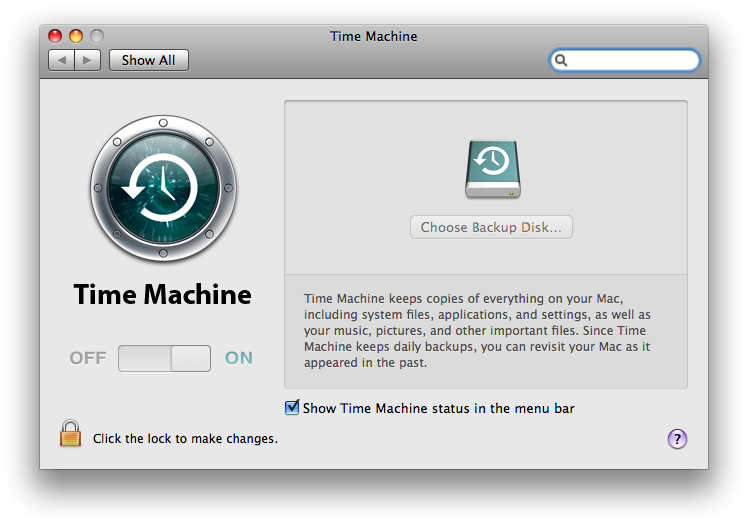These are instructions on how to enable and setup a Time Machine Backup of your hard drive in Mac OS X Leopard.
Time Machine is the breakthrough automatic backup that’s built right into Mac OS X. It keeps an up-to-date copy of everything on your Mac — digital photos, music, movies, TV shows, and documents. Now, if you ever have the need, you can easily go back in time to recover anything.
You will need a hard drive that is larger then the drive you would like to backup for use with Time Machine.
Step One
If your backup hard drive is external, connect it to your Mac.
Step Two
Launch Time Machine from the Applications folder.


Step Three
A popup may appear saying that a storage location for Time Machine backups isn't set up. Click the Set Up Time Machine button.


Step Four
The Time Machine window will open. Click the padlock at the bottom left of the window if its locked.


Step Five
A popup will appear asking you to login. Enter your administrator username and password then click OK.
Step Six
Click the Choose Backup Disk... button.
Step Seven
Select the drive you would like to use as your backup drive from the list of available hard disks. Then click the Use for Backup button.
Step Eight
Time Machine will then set itself to begin the initial backup in 120 seconds. Click the Options button.
Step Nine
You will be presented with a Do not backup list. Press the + button.
Step Ten
Select a file or folder you would like to exclude from backup and then click the Exclude button.
Step Eleven
You will notice this file or folder gets added to the Do not backup list. Click the Done button when you are finished adding to the list.
Step Twelve
Time Machine will then automatically begin its initial backup. This may take some time. For the initial backup, Time Machine copies the entire contents of the computer to your backup drive. It copies every file exactly (without compression), skipping caches and other files that aren’t required to restore your Mac to its original state. Following the initial backup, Time Machine makes only incremental backups — copying just the files that have changed since the previous backup.
Time Machine is the breakthrough automatic backup that’s built right into Mac OS X. It keeps an up-to-date copy of everything on your Mac — digital photos, music, movies, TV shows, and documents. Now, if you ever have the need, you can easily go back in time to recover anything.
You will need a hard drive that is larger then the drive you would like to backup for use with Time Machine.
Step One
If your backup hard drive is external, connect it to your Mac.
Step Two
Launch Time Machine from the Applications folder.


Step Three
A popup may appear saying that a storage location for Time Machine backups isn't set up. Click the Set Up Time Machine button.


Step Four
The Time Machine window will open. Click the padlock at the bottom left of the window if its locked.


Step Five
A popup will appear asking you to login. Enter your administrator username and password then click OK.
Step Six
Click the Choose Backup Disk... button.
Step Seven
Select the drive you would like to use as your backup drive from the list of available hard disks. Then click the Use for Backup button.
Step Eight
Time Machine will then set itself to begin the initial backup in 120 seconds. Click the Options button.
Step Nine
You will be presented with a Do not backup list. Press the + button.
Step Ten
Select a file or folder you would like to exclude from backup and then click the Exclude button.
Step Eleven
You will notice this file or folder gets added to the Do not backup list. Click the Done button when you are finished adding to the list.
Step Twelve
Time Machine will then automatically begin its initial backup. This may take some time. For the initial backup, Time Machine copies the entire contents of the computer to your backup drive. It copies every file exactly (without compression), skipping caches and other files that aren’t required to restore your Mac to its original state. Following the initial backup, Time Machine makes only incremental backups — copying just the files that have changed since the previous backup.

